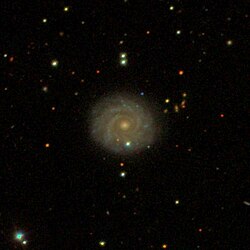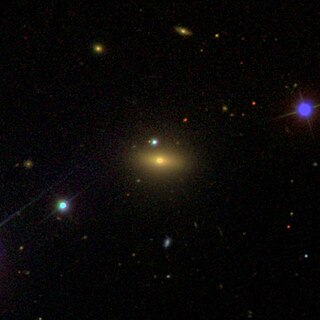
NGC 5886 is an +14 magnitude elliptical galaxy in the constellation Boötes. It was originally discovered by John Herschel in 1828 with an 18.7 inch reflector.

NGC 3626 is an unbarred lenticular galaxy and Caldwell object in the constellation Leo. It was discovered by William Herschel, on 14 March 1784. It shines at magnitude +10.6/+10.9. Its celestial coordinates are RA 11h 20.1m, dec +18° 21′. It is located near the naked-eye-class A4 star Zosma, as well as galaxies NGC 3608, NGC 3607, NGC 3659, NGC 3686, NGC 3684, NGC 3691, NGC 3681, and NGC 3655. Its dimensions are 2′.7 × 1′.9. The galaxy belongs to the NGC 3607 group some 70 million light-years distant, itself one of the many Leo II groups.

NGC 12 is an intermediate spiral galaxy in the Pisces constellation. It was discovered by William Herschel on December 6, 1790.

NGC 13 is a spiral galaxy in the constellation Andromeda. It is estimated to be about 220 million light-years away from the Sun. It was discovered on November 26, 1790 by William Herschel.

NGC 31 is a spiral galaxy located in the constellation Phoenix. It was discovered on October 28, 1834 by the astronomer John Herschel. Its morphological type is SB(rs)cd, meaning that it is a late-type barred spiral galaxy.

NGC 4780 is an intermediate spiral galaxy within the constellation Virgo. It is located about 166 million light-years away from the Sun. It was discovered in 1880 by the astronomer Wilhelm Tempel.

NGC 7499 is an unbarred lenticular galaxy within the constellation Pisces. NGC 7499 is its New General Catalogue designation. It was discovered on September 2, 1864 by the astronomer Albert Marth.
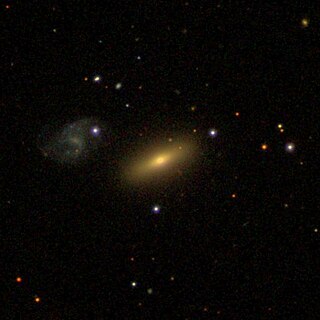
NGC 42 is a lenticular galaxy in the Pegasus constellation. It was discovered on Oct 30, 1864 by the astronomer Albert Marth. It may be gravitationally interacting with the nearby NGC 41.

NGC 4866 is an unbarred lenticular galaxy located roughly 100 million light-years away in the constellation Virgo. It was first observed by British astronomer Sir William Herschel on January 14, 1787. It is a member of the Virgo Cluster.
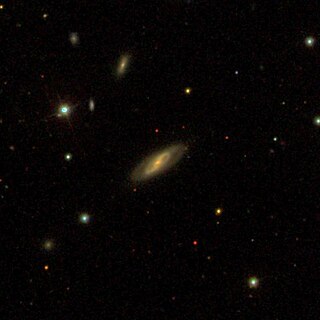
NGC 74 is a lenticular galaxy located in the Andromeda constellation. It was discovered on 7 October 1855 by Irish astronomer William Parsons.

NGC 75 is a lenticular galaxy estimated to be about 260 million light-years away in the constellation of Pisces. It was discovered by Lewis A. Swift from the USA in 1886 and its magnitude is 13.2.
NGC 7759 is a lenticular galaxy in the constellation Aquarius. It is located about 340 million light-years away from the Sun. It was discovered independently by American astronomers Lewis A. Swift and Francis Preserved Leavenworth.
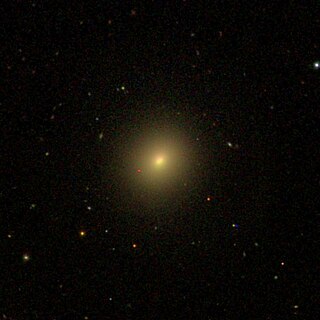
NGC 113 is an unbarred lenticular galaxy located in the constellation Cetus. It was discovered by German astronomer, Ernst Wilhelm Leberecht Tempel, on August 27, 1876.

NGC 115 is a barred spiral galaxy located in the southern constellation of Sculptor. It was discovered by the British astronomer, John Herschel, on September 25, 1834./ The galaxy is approximately 85 million light-years from the Sun, and is about 50,000 light-years in diameter, nearly half the size of our home galaxy, the Milky Way.

NGC 178 is a Magellanic spiral galaxy in the constellation of Cetus. The compiler of the New General Catalogue, John Louis Emil Dreyer noted that NGC 178 was "faint, small, much extended 0°, brighter middle". It was discovered on November 3, 1885 by Ormond Stone.

NGC 117 is a lenticular galaxy with a magnitude of 14.3 in the constellation Cetus. NGC 117 is its New General Catalogue designation. It was discovered on September 13, 1863 by the astronomer Albert Marth.

NGC 4500 is a barred spiral galaxy in the constellation Ursa Major. The galaxy was discovered on April 17, 1789 by William Herschel. It is a blue compact galaxy.

NGC 468 is a spiral galaxy in the constellation Pisces. With its distance being approximately 209 million light-years from Earth, it was discovered by John Frederick William Herschel in 1827.

NGC 471 is a lenticular galaxy located about 168 million light-years away from Earth in the constellation Pisces. It was discovered by the German astronomer Albert Marth on November 3, 1864.
NGC 7812 as is an intermediate spiral galaxy in the constellation Sculptor, though it might look like it is in Pisces if observed at the wrong angle. The galaxy was discovered on 25 September 1865 by Sir John Hershel. At its widest, it measures approximately 100-thousand light years across, and is 315 million light years away from Earth.
